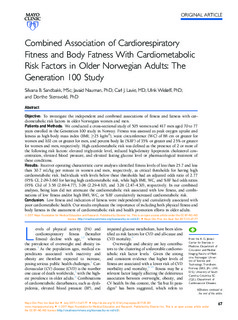| dc.contributor.author | Stensvold, Dorthe | |
| dc.contributor.author | Bucher Sandbakk, Silvana | |
| dc.contributor.author | Nauman, Javaid | |
| dc.contributor.author | Lavie, Carl J. | |
| dc.contributor.author | Wisløff, Ulrik | |
| dc.date.accessioned | 2018-01-22T14:50:19Z | |
| dc.date.available | 2018-01-22T14:50:19Z | |
| dc.date.created | 2017-10-30T10:54:54Z | |
| dc.date.issued | 2017 | |
| dc.identifier.issn | 2542-4548 | |
| dc.identifier.uri | http://hdl.handle.net/11250/2478817 | |
| dc.description.abstract | Objective
To investigate the independent and combined associations of fitness and fatness with cardiometabolic risk factors in older Norwegian women and men.
Patients and Methods
We conducted a cross-sectional study of 505 women and 417 men aged 70 to 77 years enrolled in the Generation 100 study in Norway. Fitness was assessed as peak oxygen uptake and fatness as high body mass index (BMI; ≥25 kg/m2), waist circumference (WC) of 88 cm or greater for women and 102 cm or greater for men, and percent body fat (%BF) of 35% or greater and 25% or greater for women and men, respectively. High cardiometabolic risk was defined as the presence of 2 or more of the following risk factors: elevated triglyceride level, reduced high-density lipoprotein cholesterol concentration, elevated blood pressure, and elevated fasting glucose level or pharmacological treatment of these conditions.
Results
Receiver operating characteristic curve analyses identified fitness levels of less than 25.7 and less than 30.7 mL/kg per minute in women and men, respectively, as critical thresholds for having high cardiometabolic risk. Individuals with levels below these thresholds had an adjusted odds ratio of 2.77 (95% CI, 2.09-3.66) for having high cardiometabolic risk, while high BMI, WC, and %BF had odds ratios (95% CIs) of 3.58 (2.69-4.77), 3.06 (2.29-4.10), and 3.26 (2.47-4.30), respectively. In our combined analyses, being lean did not attenuate the cardiometabolic risk associated with low fitness, and combinations of low fitness and/or high BMI, WC, or %BF cumulatively increased cardiometabolic risk.
Conclusion
Low fitness and indication of fatness were independently and cumulatively associated with poor cardiometabolic health. Our results emphasize the importance of including both physical fitness and body fatness in the assessment of cardiometabolic risk and health promotion efforts in older adults. | nb_NO |
| dc.language.iso | eng | nb_NO |
| dc.publisher | Elsevier | nb_NO |
| dc.rights | Attribution-NonCommercial-NoDerivatives 4.0 Internasjonal | * |
| dc.rights.uri | http://creativecommons.org/licenses/by-nc-nd/4.0/deed.no | * |
| dc.title | Combined Association of Cardiorespiratory Fitness and Body Fatness With Cardiometabolic Risk Factors in Older Norwegian Adults: The Generation 100 Study | nb_NO |
| dc.type | Journal article | nb_NO |
| dc.type | Peer reviewed | nb_NO |
| dc.description.version | publishedVersion | nb_NO |
| dc.source.volume | 1 | nb_NO |
| dc.source.journal | Mayo Clinic Proceedings: Innovations, Quality & Outcomes | nb_NO |
| dc.source.issue | 1 | nb_NO |
| dc.identifier.doi | 10.1016/j.mayocpiqo.2017.05.001 | |
| dc.identifier.cristin | 1508842 | |
| dc.relation.project | Norges forskningsråd: 239875 | nb_NO |
| dc.description.localcode | © 2017 Mayo Foundation for Medical Education and Research. Published by Elsevier Inc. This is an open access article under the CC BY-NC-ND license (http://creativecommons.org/licenses/by-nc-nd/4.0/). | nb_NO |
| cristin.unitcode | 194,65,25,0 | |
| cristin.unitname | Institutt for sirkulasjon og bildediagnostikk | |
| cristin.ispublished | true | |
| cristin.fulltext | original | |

